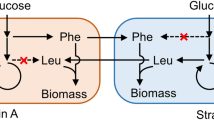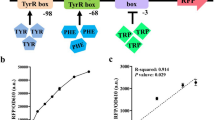Abstract
The phenylalanine pathway flux is controlled by two types of regulators, those that are specific to the pathway, as well as by global regulators. In order to demonstrate the importance of these global regulators, we first removed the pathway-specific regulators using all possible combinations of gene knockouts and knockins. We found that genes like aroG fbr performed best individually as well as in combination with other genes, while other genes like tyrA and tyrR worked only in combination with other modifications. Knocking in the tktA gene under a tyrR promoter and knocking out pykF further increased phenylalanine production demonstrating that the supply of precursor via PEP and E4P is also a rate-limiting step. Finally, we tested the role of global regulators on this deregulated pathway and found that Fis overexpression helps in both enhancing and sustaining the flux through this pathway. This work opens up the possibility of using global regulators in synergy with pathway-specific modifications to enhance product yields.







Similar content being viewed by others
References
Bongaerts, J., Krämer, M., Müller, U., Raeven, L., & Wubbolts, M. (2001). Metabolic engineering for microbial production of aromatic amino acids and derived compounds. Metabolic Engineering, 3, 289–300.
Portmann, M., & Kilcast, D. (1996). Psychophysical characterization of new sweeteners of commercial importance for the EC food industry. Food Chemistry, 56, 291–302.
Pittard, A. J. (1996). Biosynthesis of aromatic amino acids. In F. C. Neidhardt (Ed.), Escherichia coli and Salmonella: Cellular and molecular biology (Vol. 1, pp. 458–484)., ASM DC: Washington.
Lütke-Eversloh, T., & Stephanopoulos, G. (2007). l-Tyrosine production by deregulated strains of Escherichia coli. Applied Microbiology and Biotechnology, 75, 103–110.
Rodriguez, A., Martinez, J. A., Flores, N., Escalante, A., Gosset, G., & Bolivar, F. (2014). Engineering Escherichia coli to overproduce aromatic amino acids and derived compounds. Microbial Cell Factories, 13, 126.
Weiner, M., Albermann, C., Gottlieb, K., Sprenger, G. A., & Weuster-Botz, D. (2014). Fed-batch production of l-phenylalanine from glycerol and ammonia with recombinant Escherichia coli. Biochemical Engineering Journal, 83, 62–69.
Wanner, B. L. (1996). Phosphorus assimilation and control of the phosphate regulon. Escherichia coli and Salmonella: Cellular and molecular biology (2nd ed., pp. 1357–1381). Washington, DC: ASM Press.
Huber, R., Roth, S., Rahmen, N., & Büchs, J. (2011). Utilizing high-throughput experimentation to enhance specific productivity of an E. coli T7 expression system by phosphate limitation. BMC Biotechnology, 11, 22.
Bradley, M. D., Beach, M. B., de Koning, A. P., Pratt, T. S., & Osuna, R. (2007). Effects of Fis on Escherichia coli gene expression during different growth stages. Microbiology, 153, 2922–2940.
Hägg, P., De Pohl, J. W., Abdulkarim, F., & Isaksson, L. A. (2004). A host/plasmid system that is not dependent on antibiotics and antibiotic resistance genes for stable plasmid maintenance in Escherichia coli. Journal of Biotechnology, 111, 17–30.
Datsenko, K. A., & Wanner, B. L. (2000). One-step inactivation of chromosomal genes in Escherichia coli K-12 using PCR products. Proceedings of the National Academy of Sciences of the United States of America, 97, 6640–6645.
Baba, T., Ara, T., Hasegawa, M., Takai, Y., Okumura, Y., Baba, M., et al. (2006). Construction of Escherichia coli K-12 in-frame, single-gene knockout mutants: The Keio collection. Molecular Systems Biology, 2(2006), 0008.
Thomason, L. C., Costantino, N., & Court, D. L. (2007). E. coli genome manipulation by P1 transduction. Current Protocols in Molecular Biology, 79, 1.17.1–1.17.8.
Kedar, P., Colah, R., & Shimizu, K. (2007). Proteomic investigation on the pyk-F gene knockout Escherichia coli for aromatic amino acid production. Enzyme and Microbial Technology, 41, 455–465.
Báez-Viveros, J. L., Flores, N., Juárez, K., Castillo-Espana, P., Bolívar, F., & Gosset, G. (2007). Metabolic transcription analysis of engineered Escherichia coli strains that overproduce l-phenylalanine. Microbial Cell Factories, 6, 30.
Johansson, L., Lindskog, A., Silfversparre, G., Cimander, C., Nielsen, K. F., & Lidén, G. (2005). Shikimic acid production by a modified strain of E. coli (W3110.shik1) under phosphate-limited and carbon-limited conditions. Biotechnology and Bioengineering, 92, 541–552.
Johansson, L., & Lidén, G. (2006). Transcriptome analysis of a shikimic acidproducing strain of Escherichia coli W3110 grown under carbon- and phosphate-limited conditions. Journal of Biotechnology, 126, 528–545.
Yoon, S. H., Han, M. J., Lee, S. Y., Jeong, K. J., & Yoo, J. S. (2003). Combined transcriptome and proteome analysis of Escherichia coli during high cell density culture. Biotechnology and Bioengineering, 81, 753–767.
Marzan, L. W., & Shimizu, K. (2011). Metabolic regulation of Escherichia coli and its phoB and phoR genes knockout mutants under phosphate and nitrogen limitations as well as at acidic condition. Microbial Cell Factories, 10, 39.
Kikuchi, Y., Tsujimoto, K., & Kurahashi, O. (1997). Mutational analysis of the feedback sites of phenylalanine-sensitive 3-deoxy-D-arabinoheptulosonate-7-phosphate synthase of Escherichia coli. Applied and Environment Microbiology, 63, 761–762.
De Mey, M., De Maeseneire, S., Soetaert, W., & Vandamme, E. (2007). Minimizing acetate formation in E. coli fermentations. Journal of Industrial Microbiology and Biotechnology, 34, 689–700.
Vemuri, G. N., Altman, E., Sangurdekar, D. P., Khodursky, A. B., & Eiteman, M. A. (2006). Overflow metabolism in Escherichia coli during steady-state growth: transcriptional regulation and effect of the redox ratio. Applied and Environment Microbiology, 72, 3653–3661.
Li, M., Yao, S., & Shimizu, K. (2007). Effect of poxB gene knockout on metabolism in Escherichia coli based on growth characteristics and enzyme activities. World Journal of Microbiology and Biotechnology, 23, 573–580.
Polen, T., Krämer, M., Bongaerts, J., Wubbolts, M., & Wendisch, V. F. (2005). The global gene expression response of Escherichia coli to l-phenylalanine. Journal of Biotechnology, 115, 221–237.
Grinter, N. J. (1998). Developing an l-phenylalanine process. ChemTech, 28, 33–35.
Draths, K. M., Pompliano, D. L., Conley, D. L., Frost, J. W., Berry, A., Disbrow, G. L., et al. (1992). Biocatalytic synthesis of aromatics from d-Glucose: The role of transketolase. Journal of the American Chemical Society, 114, 3956–3962.
Patnaik, R., Spitzer, R. G., & Liao, J. C. (1995). Pathway engineering for production of aromatics in Escherichia coli: Confirmation of stoichiometric analysis by independent modulation of AroG, TktA, and Pps activities. Biotechnology and Bioengineering, 46, 361–370.
Shen, T., Liu, Q., Xie, X., Xu, Q., & Chen, N. (2012). Improved production of tryptophan in genetically engineered Escherichia coli with TktA and PpsA overexpression. Journal of Biomedicine and Biotechnology. doi:10.1155/2012/605219.
Liu, S. P., Liu, R. X., Xiao, M. R., Zhang, L., Ding, Z. Y., Gu, Z. H., et al. (2014). A systems level engineered E. coli capable of efficiently producing l-phenylalanine. Process Biochemistry, 49, 751–757.
Bang, H. B., Lee, Y. H., Kim, S. C., Sung, C. K., & Jeong, K. J. (2016). Metabolic engineering of Escherichia coli for the production of cinnamaldehyde. Microbial Cell Factories, 15, 16.
Martinez-Antonio, A., & Collado-Vides, J. (2003). Identifying global regulators in transcriptional regulatory networks in bacteria. Current Opinion in Microbiology, 6, 482–489.
Chen, C. C., Walia, R., Mukherjee, K. J., Mahalik, S., & Summers, D. K. (2015). Indole generates quiescent and metabolically active Escherichia coli cultures. Biotechnology Journal, 10, 636–646.
Acknowledgements
We thank Dr. Jean Pierre Hernalsteens, Belgium for providing plasmids pKD3, pKD4 pKD46 and pCP20. NT wishes to acknowledge Council of Scientific and Industrial Research, Government of India, and DST-Purse grants for providing the fellowship. The DBT-BUILDER Project (BT/PR5006/INF/22/153/2012) is acknowledged for instrument facility. The author also wishes to acknowledge the GLP and CIF facility in SBT-JNU.
Author information
Authors and Affiliations
Corresponding author
Rights and permissions
About this article
Cite this article
Tyagi, N., Saini, D., Guleria, R. et al. Designing an Escherichia coli Strain for Phenylalanine Overproduction by Metabolic Engineering. Mol Biotechnol 59, 168–178 (2017). https://doi.org/10.1007/s12033-017-9999-5
Published:
Issue Date:
DOI: https://doi.org/10.1007/s12033-017-9999-5




